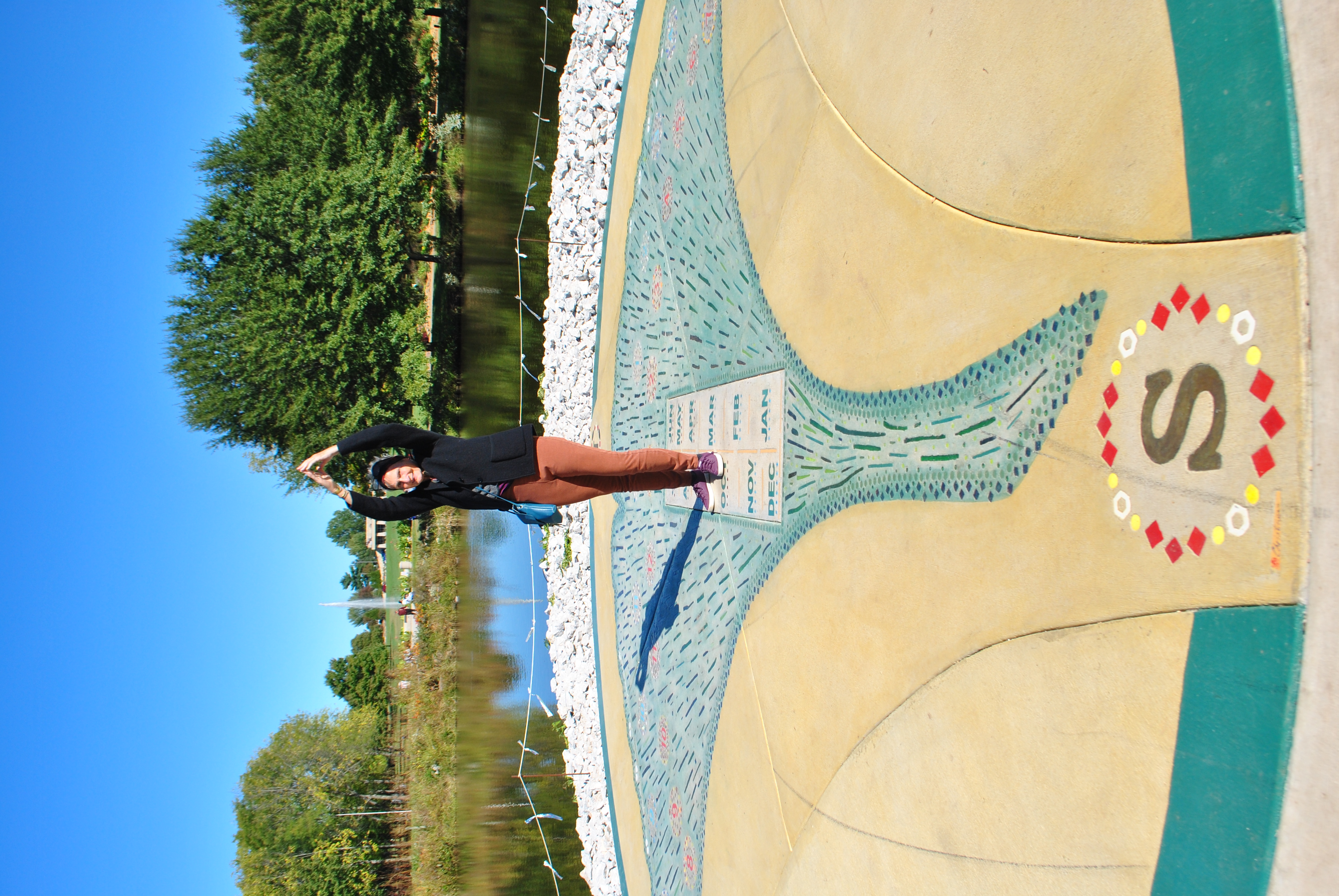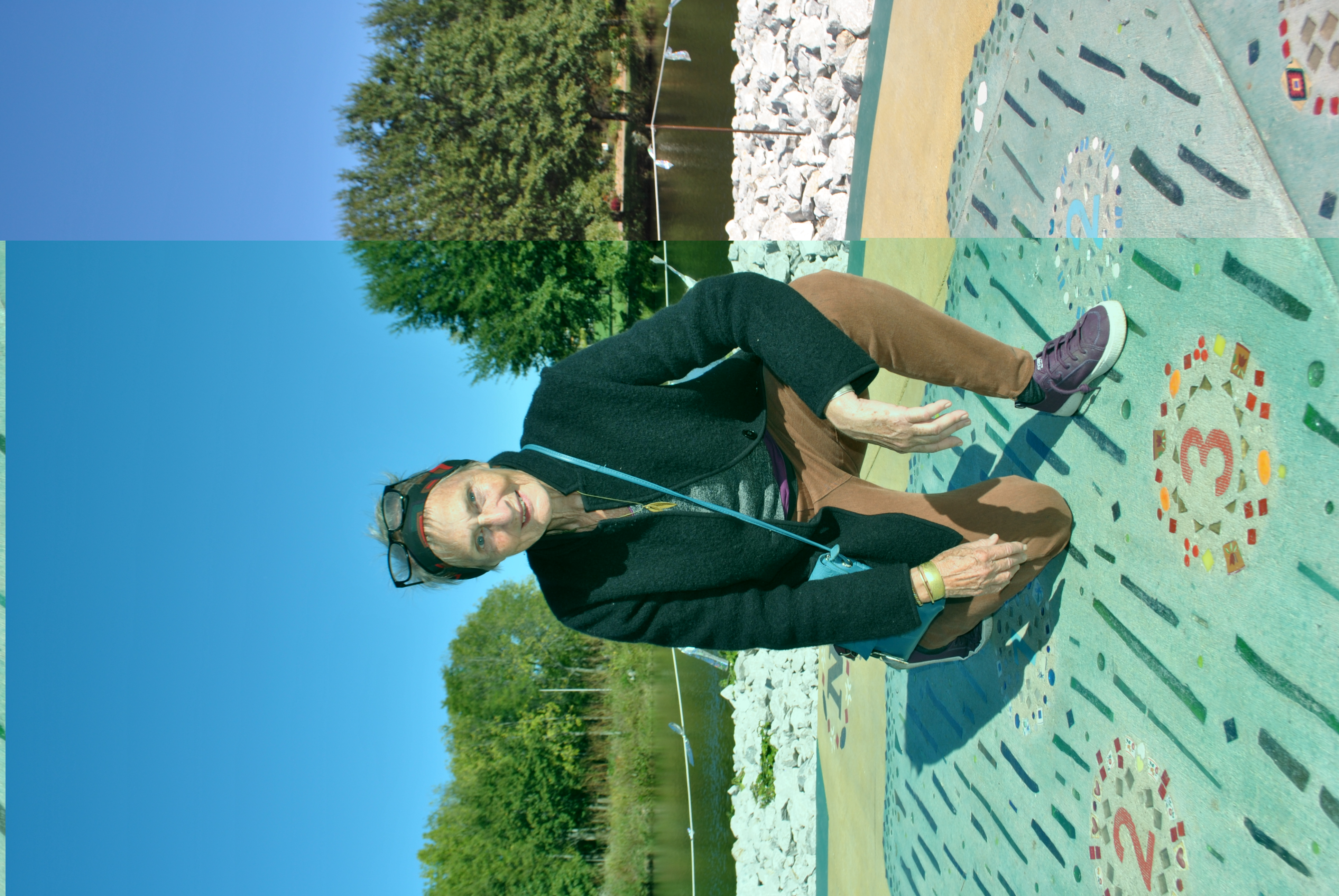A quick look at a cell phone. A glance at a smartwatch.
That’s all it takes to check the time in our digital-dependent age. We need our technology, but beyond a few battery charges and software updates, it doesn’t need us.
Yet within a new mosaic at the Springfield Botanical Gardens at Nathanael Greene-Close Memorial Park, it takes a little more human participation to answer the question, “What time is it?”
Three years in the planning and creating, the Ginkgo Mosaic Human Sundial on the south side of Lake Drummond at the park will be dedicated on Saturday — at 10:30 a.m., to be exact, to coincide with the beginning of the annular solar eclipse.
Scheduling the dedication to coincide with the eclipse seemed fitting,
“That was so fun,” Friends of the Garden Executive Director Heather Parker said of realizing that the moon’s partial blocking of the sun — enough to create a ring of sunlight — would take place on one of the weekends considered for the event.
Place on a peninsula
George Heinz, a Springfield physician, and his wife, Kathryn Hope, retired head of Missouri State University’s Department of Nursing, funded the creation of the sundial. Helping to renovate an area around the lake as a tribute to Anne Drummond, one of Heinz’s patients many years ago, they realized the peninsula at the lake got little to no use.

What’s now called Drummond Peninsula seemed to be the perfect place for a sundial, Heinz said.
“I’ve always had an interest in the measurement of time,” he said. “Our house is full of clocks.”
At the sundial, a visitor can tell time by lifting their arms above their head as they step onto a block labeled with the month.
“This is a human sun clock,” said Springfield mosaic artist Christine Schilling, who created the sundial, “meaning you as a human make it work.“
“Your arm raised up is the gnomon,” she said. “The gnomon is the shadow-caster that actually tells you the hour, but in this case, there is no shadow-caster. You are the shadow-caster.”
Sundial building is a ‘complex project’
While checking the time on modern clocks and watches sends most of us scurrying off to our next appointments, this timepiece beckons passersby to slow down.
The sundial is not just an ordinary clock face: It’s green, shaped like a ginkgo leaf.
Bits and pieces of ceramic and glass are set into patterns around each hour of the day; lines of green glass form the leaf’s veins, reflecting the sun shining down at the edge of the lake.
“It’s just so welcoming,” Schilling said. “It draws you in, and hopefully you ask questions.”
Want to go?
What: Ginkgo Mosaic Human Sundial Dedication
When: Saturday from 10:30 a.m.-2 p.m. The dedication ceremony is at 10:30.
Where: The dedication will take place at the Drummond Peninsula south of Lake Drummond at the Botanical Center at Nathanael Greene/Close Memorial Park. After that, the Springfield-Greene County Library will host story walks, and the Springfield Astronomical Society will have sun-viewing telescopes set up on the Botanical Center’s rooftop plaza.
What else: The Hauxeda's Neighborhood Guide for southwest Springfield near Nathanael Greene/Close Memorial Park
Walking onto the sundial on a sunny Wednesday morning — shortly before 10 a.m., according to the shadow cast by Schilling’s raised arms — she described the collaborative process that led to the art’s creation.
After Heinz and Hope said they wanted to fund the sundial, Botanical Center Coordinator Katie Keith contacted Schilling to ask if she could design it.
The human sundial is Schilling’s second mosaic at Nathanael Greene Park. Her first, completed in 2010, is the centerpiece of the Mosaic Garden..
“I love sundials, so I said, sure, that’s fine,” Schilling said. Schilling is the owner of MosaicaRose Studio on Springfield’s Commercial Street. The New York native started her career as a ceramics artist, then began making mosaics for schools and communities as an artist in residence for the Missouri Council of the Arts in the 1980s and 1990s.
Pushing past the challenges
Schilling had made sundials before, but never one without an inanimate gnomon. The challenge appealed to her.
“I really will only take on a project if it will teach me something I don’t already know,” Schilling said.

Working on the human sundial, she and a team of county staff and volunteers discovered there was plenty to learn.
Jeff Smith, senior parks planner for the Springfield-Greene County Park Board, worked alongside Schilling to execute the project, which he called “one of the most complex projects that we’ve done in parks in quite a while.”
At first, the most difficult challenge was figuring out how to make a sundial fit the peninsula, a fan-shaped piece of land next to the lake. Designing the timepiece was the next challenge, Smith said.
“When we started the whole process we weren’t quite sure really how to go about designing a sundial,” Smith explained. Without basic plans from a United Kingdom company that uses longitude and latitude measurements to calculate positions for month blocks and hours, there would have been “a lot of trigonometry,” he added.
“Those plans only cost us $300, and it was $300 well spent,” said Smith, who was then able to use his computer to scale the plans to fit the space.
Ginkgo leaf symbolizes hope
Schilling pondered the peninsula itself and what shape would fit there — “Is it a heart? Is it a leaf?” Schilling asked. She realized as she sketched that it was already shaped like a leaf from a ginkgo tree. To Schilling, that seemed the right choice for several reasons.
They’re all over Springfield, Schilling said, and many people love them. Ginkgo trees also survived Hiroshima, the World War II bombing of Japan; today, Isesaki, in Gunma, Japan, is one of Springfield’s sister cities.
“They’re a symbol of hope,” Schilling said.
Within the edges of that leaf, she hoped to tell a story, and to teach.
It’s one thing to be a “lover of bits and bobs,” said Schilling, a collector of everything from buttons to keys to stones and shells since she was a child inspired by grandmothers with eyes for small, beautiful objects.
“But putting them together in a mosaic is a different thing, and I think you have to be a storyteller to develop something like this,” she said. “You have to decide what’s your story, what do you want to say, who do you want to see it?
These are the questions she had as she designed the mosaic at her studio, looking down on it from her deck as it came to life in her courtyard. Outdoor mosaics, she explained, must be flipped upside down as mirror images, with weatherproof pieces glued to mesh that is then rolled onto wet concrete.
Hidden meanings within work of art
There are “secrets” within the human sundial, Schilling said, and she wants visitors to find them.
For example, it’s not by chance that the mosaic’s compass points are different colors.
“Many cultures associate the directions with a color,” Schilling said.
In some indigenous cultures, East is represented by blue, yellow or green, so Schilling used those colors at that point in the sundial. And black, red or white represent North in some cultures, so she used those colors along with snowflakes at that point.
Likewise, each hour of the clock tells a story and offers a lesson: At 12 o’clock, they’ll find a sun high in the sky, along with sun-loving watermelons, flowers, lemons and pears. At 1 o’clock, they’ll find one blue cat, a fragment from a dish or Christmas ornament among Schilling’s collections.
At three o’clock, there are three petals on tulips, three leaves on a flower — all details to provoke curiosity. Such details are noted on a “treasure map” Schilling created for children to follow when they visit.
“In every (tile), there’s something like that,” Schilling said, adding that there are “no accidents” in the mosaic.
Well, except for the goose droppings.
Geese appreciate art?
As the concrete was poured around the sundial, Schilling and a team of friends, volunteers and contractors realized “it was very clear that geese loved it also,” she said. With the lake close by, it was a no-win situation, so Schilling scooped up a few droppings, took them to a store, and asked for “goose poop yellow” paint to camouflage the space around the mosaic.
Then there are the leaf’s green veins: They’re made from the glass of bottles — most of them wine bottles — donated by friends, Schilling said.
Cutting the bottles and melting the glass to layer it, she made it thicker and strong enough to withstand the elements.
Along the way, Schilling also had some fun: “I drank a lot of that wine with friends,” she said.
And not everything was planned from the beginning. When spring rains made the ground too soppy to install the mosaic, Schilling went to Europe for three months.
When she returned, she added bits and pieces along the edge of the leaf.
A unique focal point
Most visitors will never know those back stories about the creation of the sundial, but thanks to curriculum guides being developed at the Botanical Center, park and Friends of the Garden staff who have observed the project from the beginning are excited about the educational possibilities of the new attraction.
“Really, I think this will be something educational for people of all ages,” Parker said. “I really think it will be a unique and important focal point for the gardens.”
For her part, Schilling said she was “astonished” by the support she received from park staff, contractors and the team of friends and volunteers it took to complete the sundial.
And she likes that the finished mosaic has function as well as form.
“It is an interesting and I think a beautiful shape and a beautiful object, but it’s an instrument,” Schilling said.


